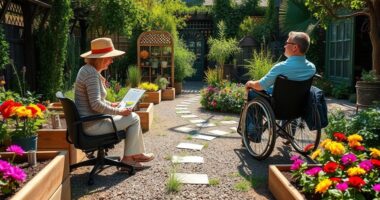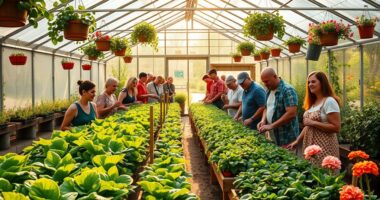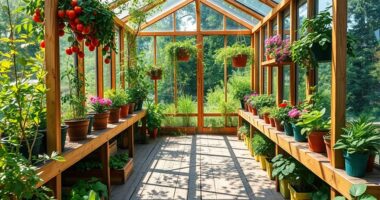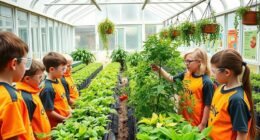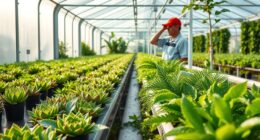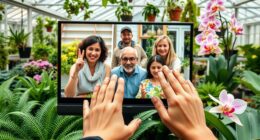Visiting a local school greenhouse program lets you see how students engage with hands-on plant science and environmental education. You’ll observe them learn plant propagation techniques, care for seedlings, and understand sustainability through practical activities. The greenhouse design maximizes sunlight and supports healthy growth, fostering curiosity and responsibility. As you explore, you’ll notice how these programs inspire teamwork and environmental stewardship—if you keep exploring, you’ll discover even more about their impact.
Key Takeaways
- Experience hands-on learning by participating in plant propagation activities like seed starting and taking cuttings.
- Observe how the greenhouse environment is designed to optimize plant growth and sustainability.
- Engage with students and educators to learn about plant life cycles and environmental stewardship efforts.
- Explore different sections of the greenhouse dedicated to seed sowing, growing, and experimentation.
- Discover how the greenhouse fosters teamwork, responsibility, and curiosity about nature and sustainability.
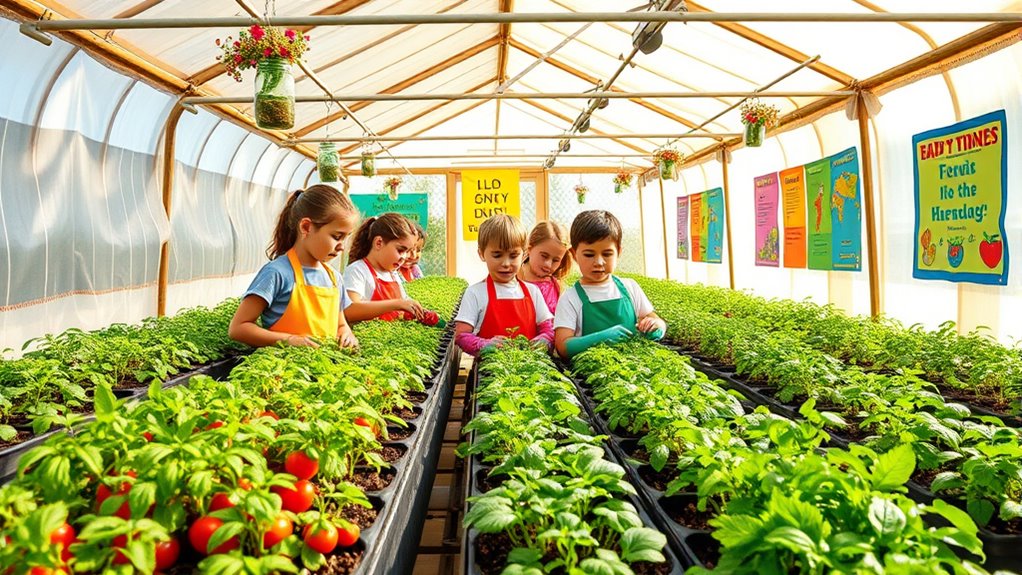
Ever wondered how a school greenhouse can inspire young minds and foster a love for nature? When you step into one, you’re entering a space where curiosity blossoms alongside plants. School greenhouses serve as dynamic classrooms, where students learn about plant propagation firsthand. You’ll see them carefully sowing seeds, taking cuttings, and understanding how different plants grow from various propagation methods. It’s a powerful way to connect students with the life cycle of plants, showing them that nurturing nature requires patience and care.
The greenhouse design plays an essential role in creating an environment that optimizes plant growth and learning. You’ll notice how these structures are often crafted to maximize sunlight, with transparent panels and proper ventilation. This thoughtful design guarantees that young plants stay healthy and thrive, even during colder months. It also encourages students to observe how environmental factors like temperature, humidity, and light influence plant development. The layout is usually both functional and inviting, with designated areas for seed starting, growing, and experimenting. This setup allows students to engage with hands-on activities that reinforce classroom lessons, making learning more tangible and memorable.
In these greenhouses, plant propagation isn’t just a theory; it’s a practical experience. You’ll see students experimenting with different techniques—starting seeds in trays, taking cuttings from mature plants, or layering stems to grow new roots. They learn to select healthy parent plants and understand the importance of maintaining sterile conditions to prevent disease. Such activities teach them responsibility, patience, and the scientific method. Plus, they get to witness the immediate results of their efforts, which boosts confidence and curiosity.
The design of the greenhouse also fosters collaboration. Students often work together, sharing insights and troubleshooting issues like mold or pests. This teamwork enhances their problem-solving skills and instills a sense of community. As they see their plants grow, they develop a deeper appreciation for environmental stewardship. The design encourages exploration and experimentation, making it easy for students to observe plant growth from seed to transplant, fostering a love for sustainability and ecology.
Additionally, understanding how regional climate influences plant growth can help students appreciate the importance of greenhouse design in different environments and ensure successful propagation regardless of external weather conditions. Visiting a school greenhouse isn’t just about seeing plants; it’s about experiencing a mini-ecosystem that teaches fundamental lessons. You leave with a newfound appreciation for how thoughtful greenhouse design and effective plant propagation techniques create a nurturing environment for young learners. It’s a vibrant, inspiring space where education and nature grow hand in hand.
Frequently Asked Questions
How Can I Volunteer to Help in the Greenhouse?
You can volunteer to help in the greenhouse by contacting the program directly through their website or phone number. They often look for volunteers interested in plant care and educational activities. You might also check local community boards or social media for volunteer opportunities. When you get involved, you’ll assist with watering, planting, and maintaining the greenhouse, gaining hands-on experience while supporting the program’s educational mission.
What Safety Precautions Are Taken for Visitors?
You might worry about safety, but the greenhouse prioritizes visitor safety through strict protocols. Greenhouse protocols include wearing protective gear like gloves and hats, staying on designated paths, and avoiding touching plants or equipment without guidance. Staff actively supervise visitors to ensure everyone follows safety rules. These measures help you enjoy the experience while staying safe, making your visit both fun and secure without any concerns.
Are There Specific Times When the Greenhouse Is Open?
You can visit the greenhouse during scheduled hours, often aligned with seasonal tours and plant sales. These times are usually posted on the school’s website or notice boards. During these open hours, you’ll have the chance to explore the greenhouse, learn about different plants, and purchase seasonal plants. Be sure to check the schedule ahead of time to plan your visit and enjoy the full experience of the greenhouse’s offerings.
Can I Purchase Plants Directly From the Greenhouse?
Yes, you can purchase plants directly from the greenhouse. They often have a variety of plants, including rare plants, available for sale. This is a great chance to see plant propagation in action and select healthy, young plants for your garden. Be sure to visit during open hours, and ask staff about specific plants you’re interested in. Supporting the greenhouse helps promote education and conservation efforts.
How Does the Program Integrate With the School’s Curriculum?
You can see how the program integrates with the school’s curriculum by actively participating in hands-on activities aligned with educational goals. It enhances lessons in science, ecology, and sustainability, making learning more engaging. Teachers incorporate greenhouse projects to reinforce concepts, fostering critical thinking and practical skills. This seamless curriculum integration helps students connect classroom theory to real-world applications, enriching their overall educational experience while supporting the school’s broader learning objectives.
Conclusion
Visiting a local school greenhouse program lets you see growth firsthand, feel the excitement of discovery, and experience the joy of learning. It’s about witnessing nature’s beauty, understanding the importance of sustainability, and inspiring future gardeners. It’s about connecting with students, sharing in their curiosity, and nurturing their passions. It’s about planting seeds of knowledge, cultivating skills, and encouraging a love for the environment. Visiting a greenhouse is more than an outing; it’s an unforgettable journey of growth.


